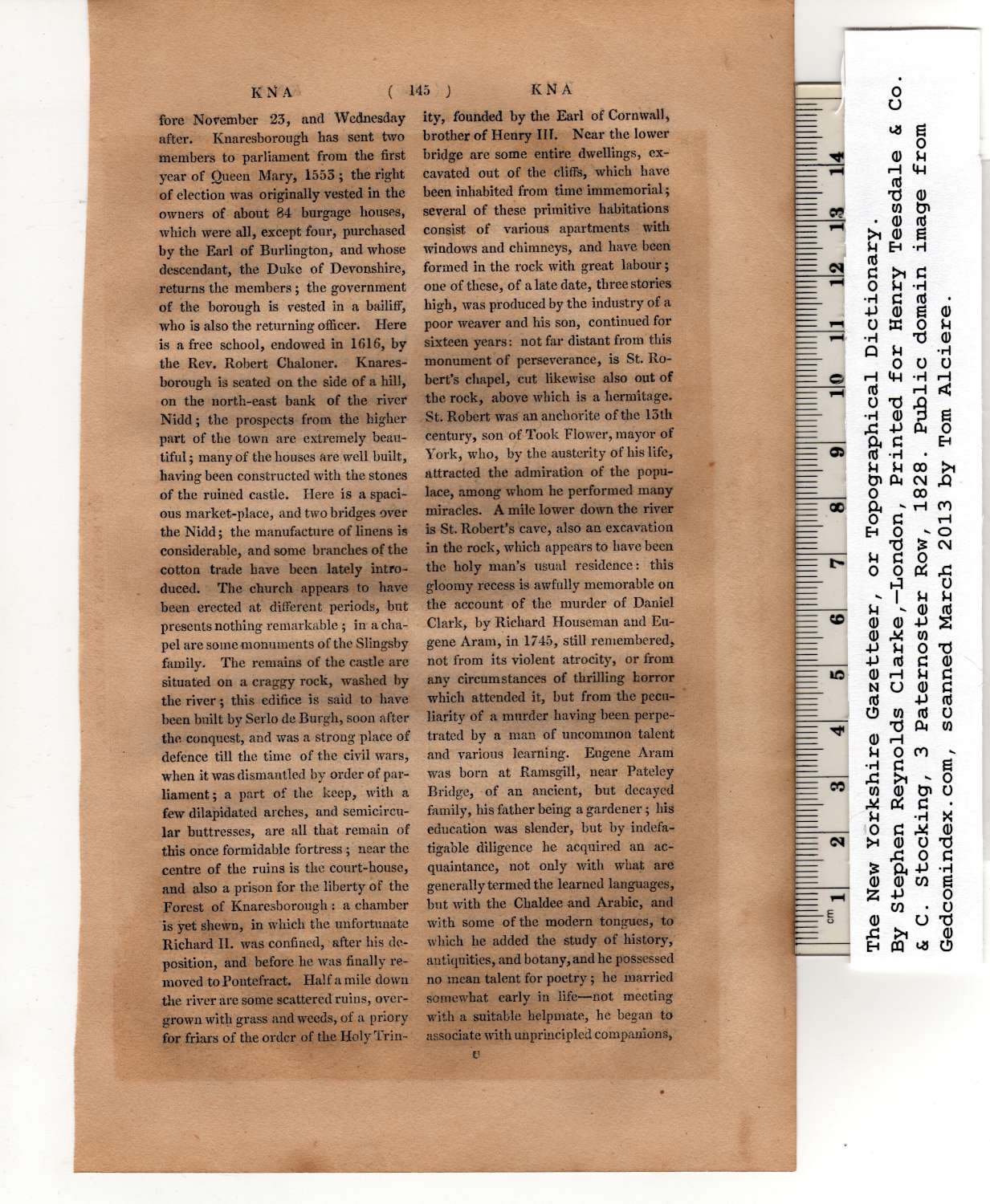|
fore November 23, and Wednesday
after. Knaresborough has sent two
members to parliament from the first
year of Queen Mary, 1553 ; the right
of election was originally vested in the
owners of about 84 burgage houses,
which were all, except four, purchased
by the Earl of Burlington, and whose
descendant, the Duke of Devonshire,
returns the members; the government
of the borough is vested in a bailiff,
who is also the returning officer. Here
is a free school, endowed in 1616, by
the Rev. Robert Chaloner. Knares-
borough is seated on the side of a hill,
on the north-east bank of the river
Nidd; the prospects from the higher
part of the town are extremely beau-
tiful; many of the houses are well built,
having been constructed with the stones
of the ruined castle. Here is a spaci-
ous market-place, and two bridges over
the Nidd; the manufacture of linens is
considerable, and some branches of the
cotton trade have been lately intro-
duced. The church appears to have
been erected at different periods, but
presents nothing remarkable; in a cha-
pel are some monuments of the Slingsby
family. The remains of the castle are
situated on a craggy rock, washed by
the river; this edifice is said to have
been built by Serlo de Burgh, soon after
the conquest, and was a strong place of
defence till the time of the civil wars,
when it was dismantled by order of par-
liament; a part of the keep, with a
few dilapidated arches, and semicircu-
lar buttresses, are all that remain of
this once formidable fortress; near the
centre of the ruins is the court-house,
and also a prison for the liberty of the
Forest of Knaresborough : a chamber
is yet shewn, in which the unfortunate
Richard II. was confined, after his de-
position, and before he was finally re-
moved to Pontefract. Half a mile down
the river are some scattered ruins, over-
grown with grass and weeds, of a priory
for friars of the order of the Holy Trin-
ity, founded by the Earl of Cornwall,
brother of Henry III. Near the lower
bridge are some entire dwellings, ex-
cavated out of the cliffs, which have
been inhabited from time immemorial;
several of these primitive habitations
consist of various apartments with
windows and chimneys, and have been
formed in the rock with great labour;
one of these, of a late date, three stories
high, was produced by the industry of a
poor weaver and his son, continued for
sixteen years: not far distant from this
monument of perseverance, is St. Ro-
bert’s chapel, cut likewise also out of
the rock, above which is a hermitage.
St. Robert was an anchorite of the 13th
century, son of Took Flower, mayor of
York, who, by the austerity of his life,
attracted the admiration of the popu-
lace, among whom he performed many
miracles. A mile lower down the river
is St. Robert’s cave, also an excavation
in the rock, which appears to have been
the holy man’s usual residence: this
gloomy recess is awfully memorable on
the account of the murder of Daniel
Clark, by Richard Houseman and Eu-
gene Aram, in 1745, still remembered,
not from its violent atrocity, or from
any circumstances of thrilling horror
which attended it, but from the pecu-
liarity of a murder having been perpe-
trated by a man of uncommon talent
and various learning. Eugene Aram
was born at Ramsgill, near Pateley
Bridge, of an ancient, but decayed
family, his father being a gardener; his
education was slender, but by indefa-
tigable diligence he acquired an ac-
quaintance, not only with what are
generally termed the learned languages,
but with the Chaldee and Arabic, and
with some of the modern tongues, to
which he added the study of history,
antiquities, and botany, and he possessed
no mean talent for poetry; he married
somewhat early in life—not meeting
with a suitable helpmate, he began to
associate with unprincipled companions, |
|
